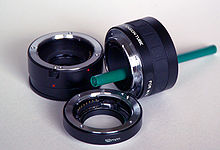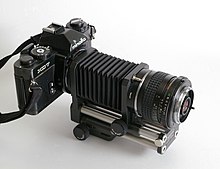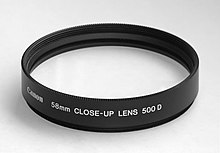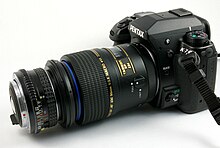Macro photography: Difference between revisions
another book ref for the definition |
DSiegfried (talk | contribs) Webster's (and several other dictionaries) define macro photography as one word: macrophotography. Ref included. |
||
| Line 1: | Line 1: | ||
[[Image:Scatophaga stercoraria macro Luc Viatour.jpg|thumb|right|200px|Photomacrograph of a [[Scathophaga stercoraria|Common Yellow Dung fly (''Scathophaga stercoraria'')]] made using a lens at its maximum 1:1 reproduction ratio, and a 18×24mm [[image sensor]], the on-screen display of the photograph results in a greater than life size image.]] |
[[Image:Scatophaga stercoraria macro Luc Viatour.jpg|thumb|right|200px|Photomacrograph of a [[Scathophaga stercoraria|Common Yellow Dung fly (''Scathophaga stercoraria'')]] made using a lens at its maximum 1:1 reproduction ratio, and a 18×24mm [[image sensor]], the on-screen display of the photograph results in a greater than life size image.]] |
||
'''Macro photography''' ( |
'''Macro photography''' ('''macrophotography''', '''photomacrography''' or simply '''macrography''') is extreme [[close-up]] [[photography]], usually of very small subjects, in which the size of the subject in the photograph is greater than life size.<ref> |
||
{{cite book |
{{cite book |
||
| title = The DSLR Field Guide: The Essential Handbook to Getting the Most from Your Camera |
| title = The DSLR Field Guide: The Essential Handbook to Getting the Most from Your Camera |
||
| Line 29: | Line 29: | ||
| page = 29 |
| page = 29 |
||
| url = http://books.google.com/books?id=LGBNEjPmLZ0C&pg=PA29 |
| url = http://books.google.com/books?id=LGBNEjPmLZ0C&pg=PA29 |
||
}}</ref> |
}}</ref><ref> |
||
{{cite book|last=Webster|first=Merriam|title=Collegiate Dictionary, 10th Ed|year=1996|publisher=Merriam-Webster, Inc|isbn=0-87779-711-0|pages=698 |
|||
}}</ref> |
|||
By some definitions, a macro photograph is one in which the size of the subject on the [[Negative (photography)|negative]] or [[image sensor]] is life size or greater.<ref name=Marom>{{cite web|last=Marom|first=Erez|title=Macro photography: Understanding magnification|url=http://www.dpreview.com/articles/6519974919/macro-photography-understanding-magnification|accessdate=20 May 2012}}</ref> However in other uses it refers to a finished photograph of a subject at greater than life size.<ref name=photography.com_1>{{cite web|last=Photography.com|title=Macro Photography|url=http://www.photography.com/articles/types-of-photography/macro-photography/|accessdate=20 May 2012}}</ref> |
By some definitions, a macro photograph is one in which the size of the subject on the [[Negative (photography)|negative]] or [[image sensor]] is life size or greater.<ref name=Marom>{{cite web|last=Marom|first=Erez|title=Macro photography: Understanding magnification|url=http://www.dpreview.com/articles/6519974919/macro-photography-understanding-magnification|accessdate=20 May 2012}}</ref> However in other uses it refers to a finished photograph of a subject at greater than life size.<ref name=photography.com_1>{{cite web|last=Photography.com|title=Macro Photography|url=http://www.photography.com/articles/types-of-photography/macro-photography/|accessdate=20 May 2012}}</ref> |
||
Revision as of 02:48, 14 June 2012

Macro photography (macrophotography, photomacrography or simply macrography) is extreme close-up photography, usually of very small subjects, in which the size of the subject in the photograph is greater than life size.[1][2][3][4] By some definitions, a macro photograph is one in which the size of the subject on the negative or image sensor is life size or greater.[5] However in other uses it refers to a finished photograph of a subject at greater than life size.[6]
The ratio of the subject size on the film plane (or sensor plane) to the actual subject size is known as the reproduction ratio. Likewise, a macro lens is classically a lens capable of reproduction ratios greater than 1:1, although it often refers to any lens with a large reproduction ratio, despite rarely exceeding 1:1.[6][7] [8] [9]
Outside of technical photography and film-based processes, where the size of the image on the negative or image sensor is the subject of discussion, the finished print or on-screen image more commonly lends a photograph its macro status. For example, when producing a 6×4 inch (15×10 cm) print using 135 format film or sensor, a life-size result is possible with a lens having only a 1:4 reproduction ratio.[10] [11]
Reproduction ratios much greater than 1:1 are considered to be photomicrography, often achieved with digital microscope.
Due to advances in sensor technology, today’s small-sensor digital cameras often rival the macro capabilities of a DSLR with a “true” macro lens, despite having a lower reproduction ratio, making macro photography more widely accessible at a lower cost.[12] [8] In the digital age, a "true" macro photograph can be more practically defined as a photograph with a vertical subject height of 24mm or less.[13]
Equipment and techniques





"Macro" lenses specifically designed for close-up work, with a long barrel for close focusing and optimized for high reproduction ratios, are one of the most common tools for macro photography. (Unlike most other lens makers, Nikon designates its macro lenses as "Micro" because of their original use in making microform.) Most modern macro lenses can focus continuously to infinity as well and can provide excellent optical quality for normal photography. True macro lenses, such as the Canon MP-E 65 mm f/2.8 or Minolta AF 3x-1x 1.7-2.8 Macro, can achieve higher magnification than life size, enabling photography of the structure of small insect eyes, snowflakes, and other minuscule objects. Others, such as the Infinity Photo-Optical's TS-160 can achieve magnifications from 0-18x on sensor, focusing from infinity down to 18mm from the object.
Macro lenses of different focal lengths find different uses:
- Continuously-variable focal length – suitable for virtually all macro subjects
- 45–65 mm – product photography, small objects that can be approached closely without causing undesirable influence, and scenes requiring natural background perspective
- 90–105 mm – insects, flowers, and small objects from a comfortable distance
- 150–200 mm – insects and other small animals where additional working distance is required
Extending the distance between the lens and the film or sensor, by inserting either extension tubes or a continuously adjustable bellows, is another equipment option for macro photography. The further the lens is from the film or sensor, the closer the focusing distance, the greater the magnification, and the darker the image given the same aperture. Tubes of various lengths can be stacked, decreasing lens-to-subject distance and increasing magnification. Bellows or tubes eliminate infinity focus. They can be used in conjunction with some other techniques such as reversing the lens.
Placing an auxiliary close-up lens (or close-up "filter") in front of the camera's lens is another option. Inexpensive screw-in or slip-on attachments provide close focusing. The possible quality is less than that of a dedicated macro lens or extension tubes, with some two-element versions being very good while many inexpensive single element lenses exhibit chromatic aberration and reduced sharpness of the resulting image. This method works with cameras that have fixed lenses, and is commonly used with bridge cameras. These lenses add diopters to the optical power of the lens, decreasing the minimum focusing distance, and allowing the camera to get closer to the subject. They are typically designated by their diopter, and can be stacked (with an additional loss of quality) to achieve the desired magnification.
Photographers may employ view camera movements and the Scheimpflug principle to place an object close to the lens in focus, while maintaining selective background focus. This technique requires the use of a view camera or perspective control lens with the ability to tilt the lens with respect to the film or sensor plane. Lenses such as the Nikon PC-E and Canon TS-E series, the Hartblei Super-Rotator, the Schneider Super Angulon, several Lensbaby models, the Zoerk Multi Focus System, and various tilt-shift adapters for medium format, allow the use of tilt in cameras with fixed lens mounts. Traditional view cameras permit such adjustment as part of their design.
Ordinary lenses can be used for macro photography by using a "reversing ring." This ring attaches to the filter thread on the front of a lens and makes it possible to attach the lens in reverse. Excellent quality results up to 4x life-size magnification are possible. For cameras with all-electronic communications between the lens and the camera body specialty reversing rings are available which preserve these communications. When used with extension tubes or bellows, a highly versatile, true macro (greater than life size) system can be assembled. Since non-macro lenses are optimized for small reproduction ratios, reversing the lens allows it to be used for reciprocally high ratios.
Macro photography may also be accomplished by mounting a lens in reverse, in front of a normally mounted lens of greater focal length, using a macro coupler which screws into the front filter threads of both lenses. This method allows most cameras to maintain the full function of electronic and mechanical communication with the normally mounted lens, for features such as open-aperture metering. The magnification ratio is calculated by dividing the focal length of the normally mounted lens by the focal length of the reversed lens (e.g., when an 18 mm lens is reverse mounted on a 300 mm lens the reproduction ratio is 16:1). The use of automatic focus is not advisable if the first lens is not of the internal-focusing type, as the extra weight of the reverse-mounted lens could damage the autofocus mechanism. Working distance is significantly less than the first lens.
Increasingly, macro photography is accomplished using compact digital cameras and small-sensor bridge cameras, combined with a high powered zoom lens and (optionally) a close-up diopter lens added to the front of the camera lens.[12][14] The high pixel density and resolving power of these cameras' sensors enable them to capture very high levels of detail at a lower reproduction ratio than is needed for film or larger DSLR sensors (often at the cost of greater image noise).[12] While reproduction ratio is useful, magnification alone says nothing about something macro photographers often care about most, which is knowing the size of the smallest object that can fill the frame. This depends partly on sensor size, and everything else being equal, a smaller sensor is capable of photographing smaller subjects.[8]
For example, a Micro Four Thirds camera with a sensor half the size of full 35 mm (a 2x crop) only requires half the 35 mm camera magnification to fill the frame with the same subject, while still resolving a similar amount of detail. Thus a photograph taken with a 12 megapixel full-frame digital SLR and a 100mm 1:1 macro lens will be practically indistinguishable from the same photo taken with a 12 megapixel Micro Four Thirds camera with a 50mm 1:2 magnification lens. In this case, 1:1 is sometimes called the 35 mm equivalent magnification, or 35mm equivalent reproduction ratio,[15][16] an extension of 35 mm equivalent focal length, and for macro work the smaller sensor camera actually benefits from the greater depth of field. Since digital compact camera sensor sizes come in a wide diversity of sizes and camera manufacturers rarely publish the macro reproduction ratios for these cameras, a good rule of thumb is that whenever a 24mm vertical object just fits, or is too tall to fit in the camera viewfinder, you are taking a macro photograph.[13]

Depth of field is extremely small when focusing on close objects. A small aperture (high f-number) is often required to produce acceptable sharpness across a three-dimensional subject. This requires either a slow shutter speed, brilliant lighting, or a high ISO. Auxiliary lighting (such as from a flash unit) is sometimes used. Uniform lighting can be difficult with subjects very close to the lens, so a ring flash is often used, especially when working distance is small. Good results can also be obtained by using a flash diffuser.
Macro photography techniques
-
Optical scheme of close-up macro photography
-
Reversed-lens macro photography optical scheme
-
Optical scheme of macro photography using reversed lens and telephoto lens
-
Optical scheme of macro photography using infinity corrected microscope objective and telephoto lensOptical scheme of macro photography using infinity corrected microscope objective and telephoto lens
-
Optical scheme of macro photography using extension tube
Technical considerations
Depth of field

Limited depth of field is an important consideration in macro photography. Like conventional lenses, macro lenses need light, and ideally would provide similar f/# to conventional lenses to provide similar exposure times. Macro lenses also have similar focal lengths, so the entrance pupil diameter is comparable to that of conventional lenses (e.g., a 100 mm f/2.8 lens has a 100 mm/2.8 = 35.7 mm entrance-pupil diameter). Because they focus at close subjects, the cone of light from a subject point to the entrance pupil is relatively obtuse (a relatively high subject numerical aperture to use microscopy terms), making the depth of field extraordinarily small. This makes it essential to focus critically on the most important part of the subject, as elements that are even a millimetre closer or farther from the focal plane might be noticeably blurred. Due to this, the use of a microscope stage is highly recommended for precise focus with large magnification such as photographing skin cells. Alternatively, more shots of the same subject can be made with slightly different focusing lengths and joined afterwards with specialized focus stacking software which picks out the sharpest parts of every image, artificially increasing depth of field.
Compact digital cameras and small-sensor bridge cameras have an incidental advantage in macro photography due to their inherently deeper depth of field.[12] For instance, some popular bridge cameras produce the equivalent magnification of a 420 mm lens on 35-mm format but only use a lens of actual focal length 89 mm (1/1.8″-type CCD) or 72 mm (1/2.5″-type CCD). (See crop factor.) At the same f/#, that corresponds to an entrance pupil 89/420 = 0.21 times the size—much smaller. Since depth of field appears to decrease with the actual focal length of the lens, not the equivalent focal length, these bridge cameras can achieve the magnification of a 420 mm lens with the greater depth of field of a much shorter lens. High-quality auxiliary close-up lenses can be used to achieve the needed close focus; they function identically to reading glasses. This effect makes it possible to achieve very high quality macro photographs with relatively inexpensive equipment, since auxiliary closeup lenses are cheaper than dedicated SLR macro lenses. However, the amount of light gathered goes by the area of the entrance pupil, so with the smaller entrance pupil only 4.5% as much light is captured; alternately the full-frame camera would produce the same image by stopping down, increasing the f/# by a factor of 420/89 = 4.7 (e.g., from f/2.8 to f/13.16).
Lighting
The problem of sufficiently and evenly lighting the subject can be difficult to overcome. Some cameras can focus on subjects so close that they touch the front of the lens. It is difficult to place a light between the camera and a subject that close, making extreme close-up photography impractical. A normal-focal-length macro lens (50 mm on a 35 mm camera) can focus so close that lighting remains difficult. To avoid this problem, many photographers use telephoto macro lenses, typically with focal lengths from about 100 to 200 mm. These are popular as they permit sufficient distance for lighting between the camera and the subject.
Ring flashes, with flash tubes arranged in a circle around the front of the lens, can be helpful in lighting at close distances. Ring lights have emerged, using white LEDs to provide a continuous light source for macro photography.
Homemade flash diffusers made out of white Styrofoam or plastic attached to a camera's built-in flash can also yield surprisingly good results by diffusing and softening the light, eliminating specular reflections and providing more even lighting.
See also
References
- ^ Michael Freeman (2010). The DSLR Field Guide: The Essential Handbook to Getting the Most from Your Camera. Focal Press. p. 30. ISBN 9780240817200.
- ^ Graham Saxby (2010). The Science of Imaging: An Introduction (2nd ed.). CRC Press. p. 269. ISBN 9781439812860.
- ^ Thomas Clark (2011). Digital Macro and Close-Up Photography For Dummies. John Wiley & Sons. p. 29. ISBN 9781118089200.
- ^ Webster, Merriam (1996). Collegiate Dictionary, 10th Ed. Merriam-Webster, Inc. p. 698. ISBN 0-87779-711-0.
- ^ Marom, Erez. "Macro photography: Understanding magnification". Retrieved 20 May 2012.
- ^ a b Photography.com. "Macro Photography". Retrieved 20 May 2012.
- ^ Rockwell, Ken. "Canon 50mm Macro". Retrieved 20 May 2012.
- ^ a b c Cambridge in Colour. "Macro Camera Lenses".
- ^ Long, Ben. "How to take great macro photographs". Retrieved 20 May 2012.
- ^ Olympus. "Macrophotography and your Evolt". Retrieved 20 May 2012.
- ^ Super Tight Stuff. "Incredible Macro Insect Photos". Retrieved 20 May 2012.
- ^ a b c d Frank, Bob. "Extreme macro photography". Retrieved 20 May 2012.
- ^ a b Wattie, John. "Digital Stereo Macro Photography". Retrieved 20 May 2012.
- ^ Frank, Bob. "Equipment used to create Panasonic FZ30 macro galleries". Retrieved 23 May 2012.
- ^ Olympus Imaging Corp. "Olympus Four Thirds Lenses - Macro". Four-Thirds.org. Olympus Imaging Corp. Retrieved 9 June 2012.
- ^ Olympus Imaging Corp. "Panasonic LEICA DG MACRO-ELMARIT 45mm F2.8". Four-Thirds.org. Olympus Imaging Corp. Retrieved 9 June 2012.
External links
- Photo.net how-to — Guide to macro photography
- Make your own reversing ring out of a Pringles can by Haje Jan Kamps
- Information on inverted lenses
- Macro Photography Tutorial
- Insects-macrophotography Photos of insects
- Inexpensive Macro Photography DSLR with Manual Focus Lens
- Macro Photography Tips
- Use of Microscope Stage for Microphotography




